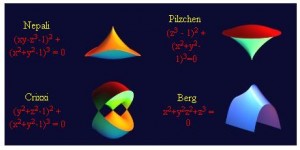 This is another wonderful visual demonstration from Jason Davies: a combinatorial bracelet generator.
This is another wonderful visual demonstration from Jason Davies: a combinatorial bracelet generator.
http://www.jasondavies.com/necklaces/
Combinatorics is the mathematics of counting things, and one of the classic “advanced” counting problems is this: given a certain number of beads of various colors, how many different bracelets can you make?
The problem may seem easy enough, but it becomes quite difficult when you start to understand what “different” really means.
For example, if you turn one bracelet into another by rotating it, then those two bracelets aren’t different. Even more complicating is that if you can obtain one bracelet from another by flipping it over, then they are also the same!
This visualization can really help develop a sense of the complicated symmetries at work here.
Click here to see more in Representation.


